Employee Representatives and Downsizing: The Role of Representatives During Downsizing
VerifiedAdded on 2023/04/26
|17
|4974
|287
AI Summary
This appears to be a summary of an assignment discussing the role of employee representatives during employee downsizing. The assignment includes an introduction, a discussion of organizational downsizing, redundancies in the UK, the impact of redundancies on the UK economy, and the rationale for the study. The assignment also includes a problem statement, research aim, research objectives, research questions, and the significance of the study. Is there anything specific you would like to know more about?
Contribute Materials
Your contribution can guide someone’s learning journey. Share your
documents today.
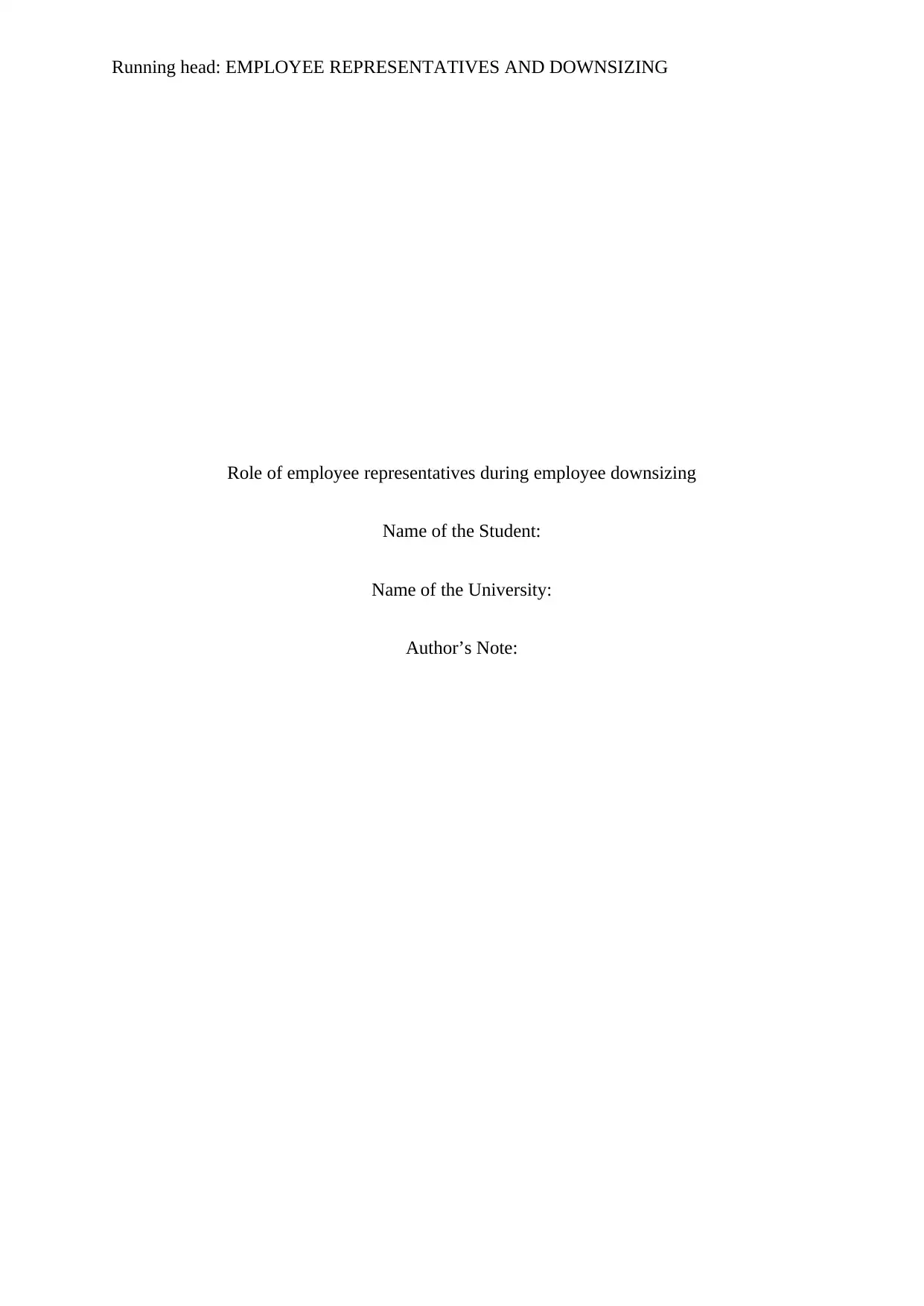
Running head: EMPLOYEE REPRESENTATIVES AND DOWNSIZING
Role of employee representatives during employee downsizing
Name of the Student:
Name of the University:
Author’s Note:
Role of employee representatives during employee downsizing
Name of the Student:
Name of the University:
Author’s Note:
Secure Best Marks with AI Grader
Need help grading? Try our AI Grader for instant feedback on your assignments.
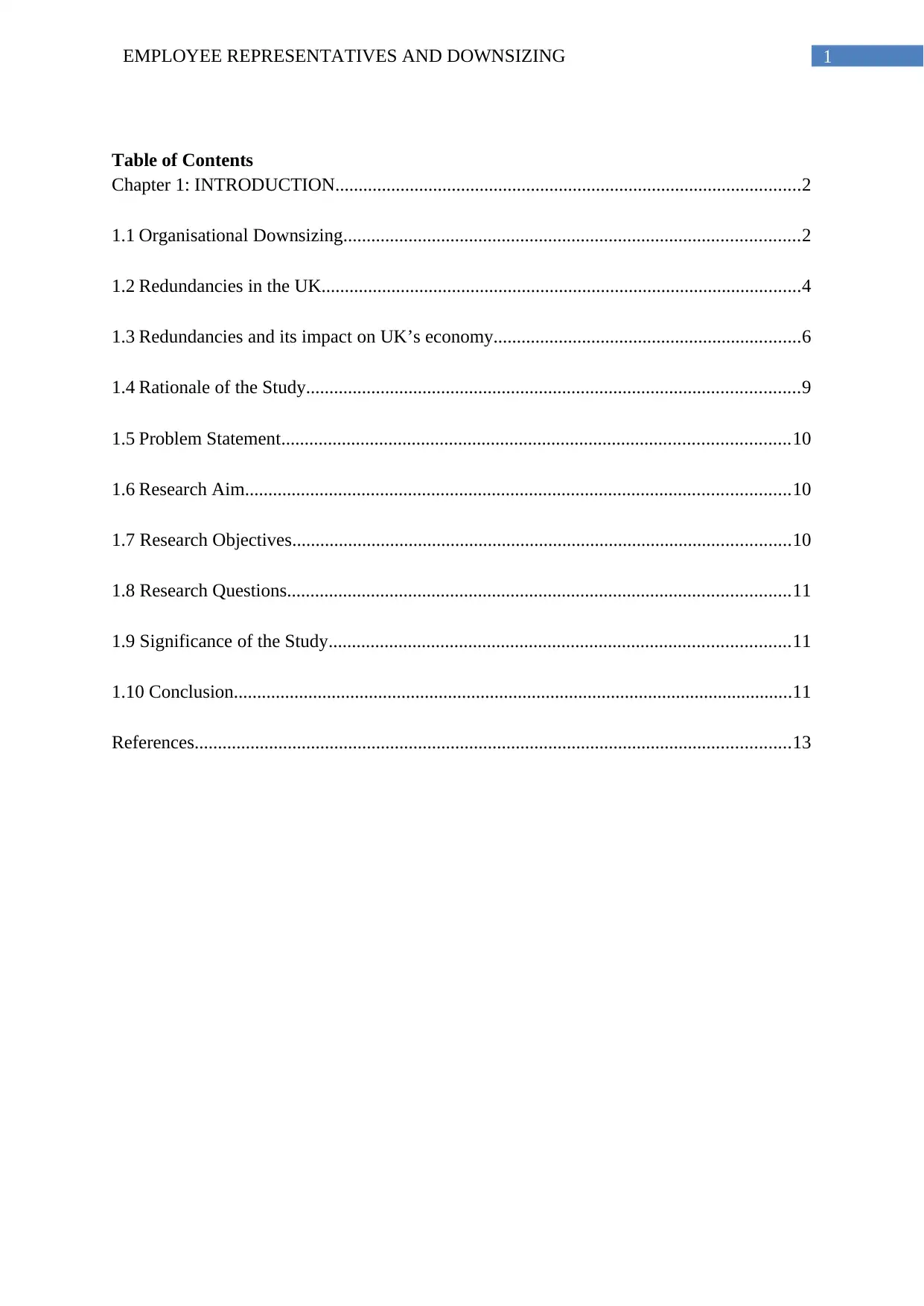
1EMPLOYEE REPRESENTATIVES AND DOWNSIZING
Table of Contents
Chapter 1: INTRODUCTION....................................................................................................2
1.1 Organisational Downsizing..................................................................................................2
1.2 Redundancies in the UK.......................................................................................................4
1.3 Redundancies and its impact on UK’s economy..................................................................6
1.4 Rationale of the Study..........................................................................................................9
1.5 Problem Statement.............................................................................................................10
1.6 Research Aim.....................................................................................................................10
1.7 Research Objectives...........................................................................................................10
1.8 Research Questions............................................................................................................11
1.9 Significance of the Study...................................................................................................11
1.10 Conclusion........................................................................................................................11
References................................................................................................................................13
Table of Contents
Chapter 1: INTRODUCTION....................................................................................................2
1.1 Organisational Downsizing..................................................................................................2
1.2 Redundancies in the UK.......................................................................................................4
1.3 Redundancies and its impact on UK’s economy..................................................................6
1.4 Rationale of the Study..........................................................................................................9
1.5 Problem Statement.............................................................................................................10
1.6 Research Aim.....................................................................................................................10
1.7 Research Objectives...........................................................................................................10
1.8 Research Questions............................................................................................................11
1.9 Significance of the Study...................................................................................................11
1.10 Conclusion........................................................................................................................11
References................................................................................................................................13
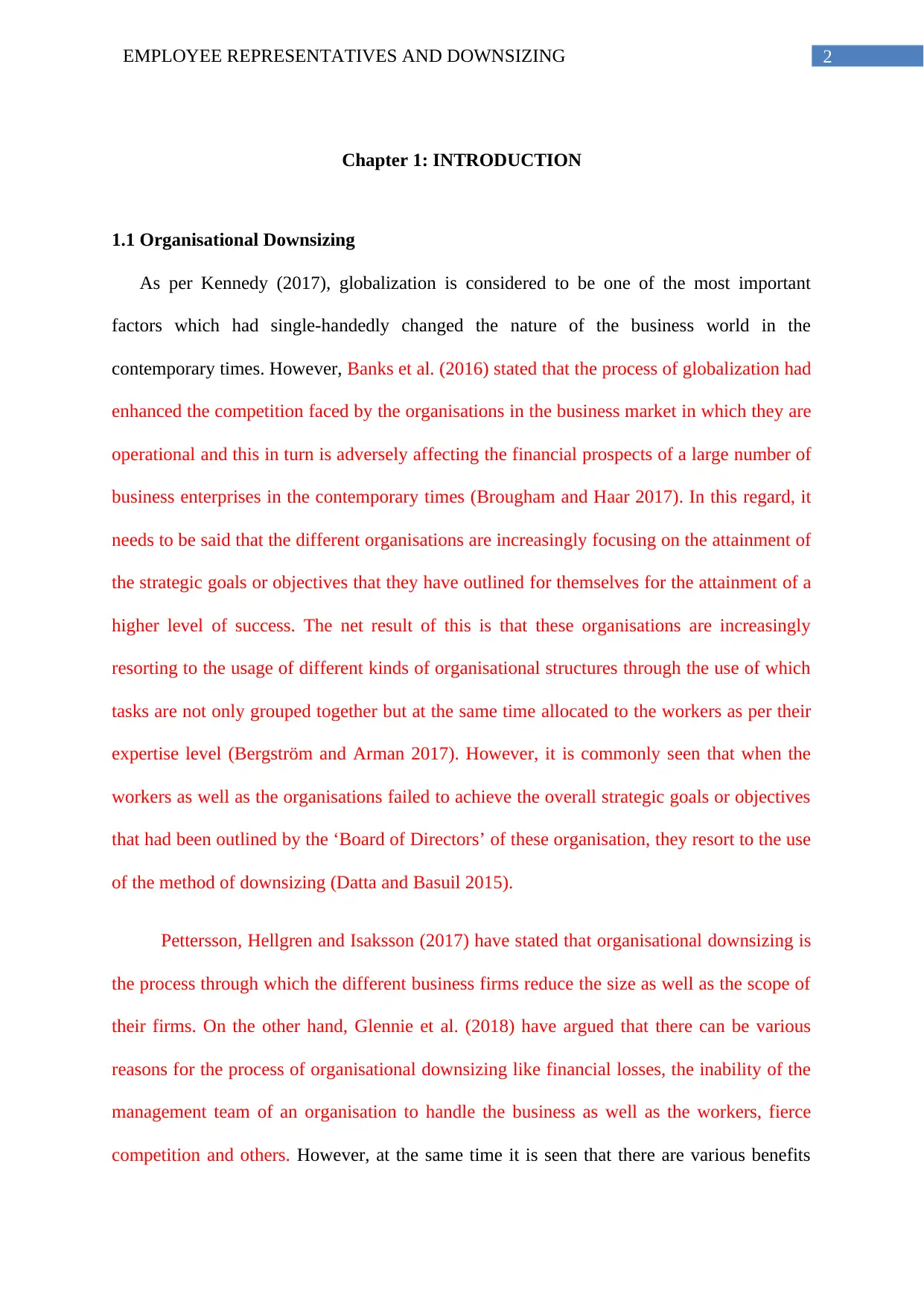
2EMPLOYEE REPRESENTATIVES AND DOWNSIZING
Chapter 1: INTRODUCTION
1.1 Organisational Downsizing
As per Kennedy (2017), globalization is considered to be one of the most important
factors which had single-handedly changed the nature of the business world in the
contemporary times. However, Banks et al. (2016) stated that the process of globalization had
enhanced the competition faced by the organisations in the business market in which they are
operational and this in turn is adversely affecting the financial prospects of a large number of
business enterprises in the contemporary times (Brougham and Haar 2017). In this regard, it
needs to be said that the different organisations are increasingly focusing on the attainment of
the strategic goals or objectives that they have outlined for themselves for the attainment of a
higher level of success. The net result of this is that these organisations are increasingly
resorting to the usage of different kinds of organisational structures through the use of which
tasks are not only grouped together but at the same time allocated to the workers as per their
expertise level (Bergström and Arman 2017). However, it is commonly seen that when the
workers as well as the organisations failed to achieve the overall strategic goals or objectives
that had been outlined by the ‘Board of Directors’ of these organisation, they resort to the use
of the method of downsizing (Datta and Basuil 2015).
Pettersson, Hellgren and Isaksson (2017) have stated that organisational downsizing is
the process through which the different business firms reduce the size as well as the scope of
their firms. On the other hand, Glennie et al. (2018) have argued that there can be various
reasons for the process of organisational downsizing like financial losses, the inability of the
management team of an organisation to handle the business as well as the workers, fierce
competition and others. However, at the same time it is seen that there are various benefits
Chapter 1: INTRODUCTION
1.1 Organisational Downsizing
As per Kennedy (2017), globalization is considered to be one of the most important
factors which had single-handedly changed the nature of the business world in the
contemporary times. However, Banks et al. (2016) stated that the process of globalization had
enhanced the competition faced by the organisations in the business market in which they are
operational and this in turn is adversely affecting the financial prospects of a large number of
business enterprises in the contemporary times (Brougham and Haar 2017). In this regard, it
needs to be said that the different organisations are increasingly focusing on the attainment of
the strategic goals or objectives that they have outlined for themselves for the attainment of a
higher level of success. The net result of this is that these organisations are increasingly
resorting to the usage of different kinds of organisational structures through the use of which
tasks are not only grouped together but at the same time allocated to the workers as per their
expertise level (Bergström and Arman 2017). However, it is commonly seen that when the
workers as well as the organisations failed to achieve the overall strategic goals or objectives
that had been outlined by the ‘Board of Directors’ of these organisation, they resort to the use
of the method of downsizing (Datta and Basuil 2015).
Pettersson, Hellgren and Isaksson (2017) have stated that organisational downsizing is
the process through which the different business firms reduce the size as well as the scope of
their firms. On the other hand, Glennie et al. (2018) have argued that there can be various
reasons for the process of organisational downsizing like financial losses, the inability of the
management team of an organisation to handle the business as well as the workers, fierce
competition and others. However, at the same time it is seen that there are various benefits
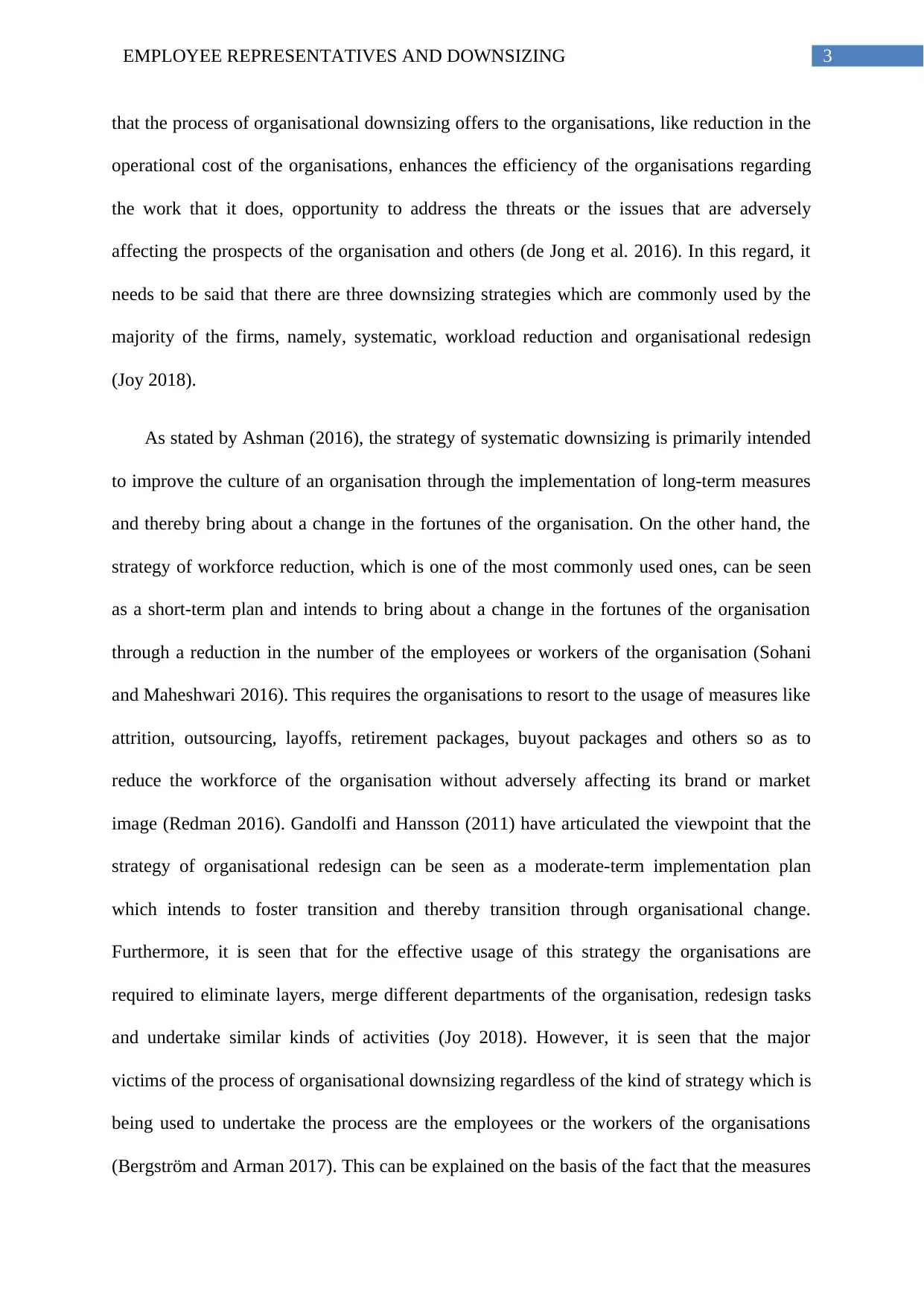
3EMPLOYEE REPRESENTATIVES AND DOWNSIZING
that the process of organisational downsizing offers to the organisations, like reduction in the
operational cost of the organisations, enhances the efficiency of the organisations regarding
the work that it does, opportunity to address the threats or the issues that are adversely
affecting the prospects of the organisation and others (de Jong et al. 2016). In this regard, it
needs to be said that there are three downsizing strategies which are commonly used by the
majority of the firms, namely, systematic, workload reduction and organisational redesign
(Joy 2018).
As stated by Ashman (2016), the strategy of systematic downsizing is primarily intended
to improve the culture of an organisation through the implementation of long-term measures
and thereby bring about a change in the fortunes of the organisation. On the other hand, the
strategy of workforce reduction, which is one of the most commonly used ones, can be seen
as a short-term plan and intends to bring about a change in the fortunes of the organisation
through a reduction in the number of the employees or workers of the organisation (Sohani
and Maheshwari 2016). This requires the organisations to resort to the usage of measures like
attrition, outsourcing, layoffs, retirement packages, buyout packages and others so as to
reduce the workforce of the organisation without adversely affecting its brand or market
image (Redman 2016). Gandolfi and Hansson (2011) have articulated the viewpoint that the
strategy of organisational redesign can be seen as a moderate-term implementation plan
which intends to foster transition and thereby transition through organisational change.
Furthermore, it is seen that for the effective usage of this strategy the organisations are
required to eliminate layers, merge different departments of the organisation, redesign tasks
and undertake similar kinds of activities (Joy 2018). However, it is seen that the major
victims of the process of organisational downsizing regardless of the kind of strategy which is
being used to undertake the process are the employees or the workers of the organisations
(Bergström and Arman 2017). This can be explained on the basis of the fact that the measures
that the process of organisational downsizing offers to the organisations, like reduction in the
operational cost of the organisations, enhances the efficiency of the organisations regarding
the work that it does, opportunity to address the threats or the issues that are adversely
affecting the prospects of the organisation and others (de Jong et al. 2016). In this regard, it
needs to be said that there are three downsizing strategies which are commonly used by the
majority of the firms, namely, systematic, workload reduction and organisational redesign
(Joy 2018).
As stated by Ashman (2016), the strategy of systematic downsizing is primarily intended
to improve the culture of an organisation through the implementation of long-term measures
and thereby bring about a change in the fortunes of the organisation. On the other hand, the
strategy of workforce reduction, which is one of the most commonly used ones, can be seen
as a short-term plan and intends to bring about a change in the fortunes of the organisation
through a reduction in the number of the employees or workers of the organisation (Sohani
and Maheshwari 2016). This requires the organisations to resort to the usage of measures like
attrition, outsourcing, layoffs, retirement packages, buyout packages and others so as to
reduce the workforce of the organisation without adversely affecting its brand or market
image (Redman 2016). Gandolfi and Hansson (2011) have articulated the viewpoint that the
strategy of organisational redesign can be seen as a moderate-term implementation plan
which intends to foster transition and thereby transition through organisational change.
Furthermore, it is seen that for the effective usage of this strategy the organisations are
required to eliminate layers, merge different departments of the organisation, redesign tasks
and undertake similar kinds of activities (Joy 2018). However, it is seen that the major
victims of the process of organisational downsizing regardless of the kind of strategy which is
being used to undertake the process are the employees or the workers of the organisations
(Bergström and Arman 2017). This can be explained on the basis of the fact that the measures
Secure Best Marks with AI Grader
Need help grading? Try our AI Grader for instant feedback on your assignments.
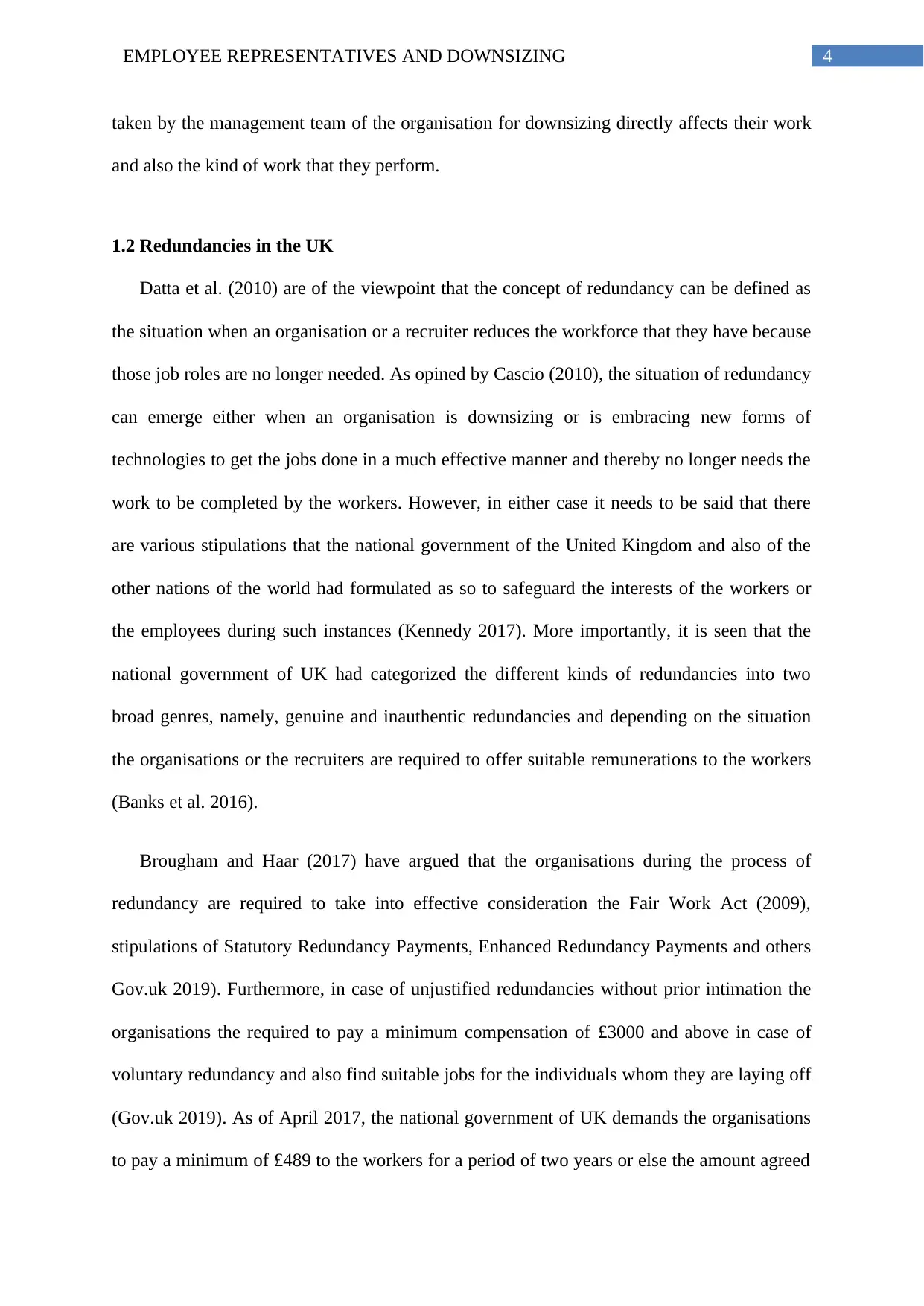
4EMPLOYEE REPRESENTATIVES AND DOWNSIZING
taken by the management team of the organisation for downsizing directly affects their work
and also the kind of work that they perform.
1.2 Redundancies in the UK
Datta et al. (2010) are of the viewpoint that the concept of redundancy can be defined as
the situation when an organisation or a recruiter reduces the workforce that they have because
those job roles are no longer needed. As opined by Cascio (2010), the situation of redundancy
can emerge either when an organisation is downsizing or is embracing new forms of
technologies to get the jobs done in a much effective manner and thereby no longer needs the
work to be completed by the workers. However, in either case it needs to be said that there
are various stipulations that the national government of the United Kingdom and also of the
other nations of the world had formulated as so to safeguard the interests of the workers or
the employees during such instances (Kennedy 2017). More importantly, it is seen that the
national government of UK had categorized the different kinds of redundancies into two
broad genres, namely, genuine and inauthentic redundancies and depending on the situation
the organisations or the recruiters are required to offer suitable remunerations to the workers
(Banks et al. 2016).
Brougham and Haar (2017) have argued that the organisations during the process of
redundancy are required to take into effective consideration the Fair Work Act (2009),
stipulations of Statutory Redundancy Payments, Enhanced Redundancy Payments and others
Gov.uk 2019). Furthermore, in case of unjustified redundancies without prior intimation the
organisations the required to pay a minimum compensation of £3000 and above in case of
voluntary redundancy and also find suitable jobs for the individuals whom they are laying off
(Gov.uk 2019). As of April 2017, the national government of UK demands the organisations
to pay a minimum of £489 to the workers for a period of two years or else the amount agreed
taken by the management team of the organisation for downsizing directly affects their work
and also the kind of work that they perform.
1.2 Redundancies in the UK
Datta et al. (2010) are of the viewpoint that the concept of redundancy can be defined as
the situation when an organisation or a recruiter reduces the workforce that they have because
those job roles are no longer needed. As opined by Cascio (2010), the situation of redundancy
can emerge either when an organisation is downsizing or is embracing new forms of
technologies to get the jobs done in a much effective manner and thereby no longer needs the
work to be completed by the workers. However, in either case it needs to be said that there
are various stipulations that the national government of the United Kingdom and also of the
other nations of the world had formulated as so to safeguard the interests of the workers or
the employees during such instances (Kennedy 2017). More importantly, it is seen that the
national government of UK had categorized the different kinds of redundancies into two
broad genres, namely, genuine and inauthentic redundancies and depending on the situation
the organisations or the recruiters are required to offer suitable remunerations to the workers
(Banks et al. 2016).
Brougham and Haar (2017) have argued that the organisations during the process of
redundancy are required to take into effective consideration the Fair Work Act (2009),
stipulations of Statutory Redundancy Payments, Enhanced Redundancy Payments and others
Gov.uk 2019). Furthermore, in case of unjustified redundancies without prior intimation the
organisations the required to pay a minimum compensation of £3000 and above in case of
voluntary redundancy and also find suitable jobs for the individuals whom they are laying off
(Gov.uk 2019). As of April 2017, the national government of UK demands the organisations
to pay a minimum of £489 to the workers for a period of two years or else the amount agreed
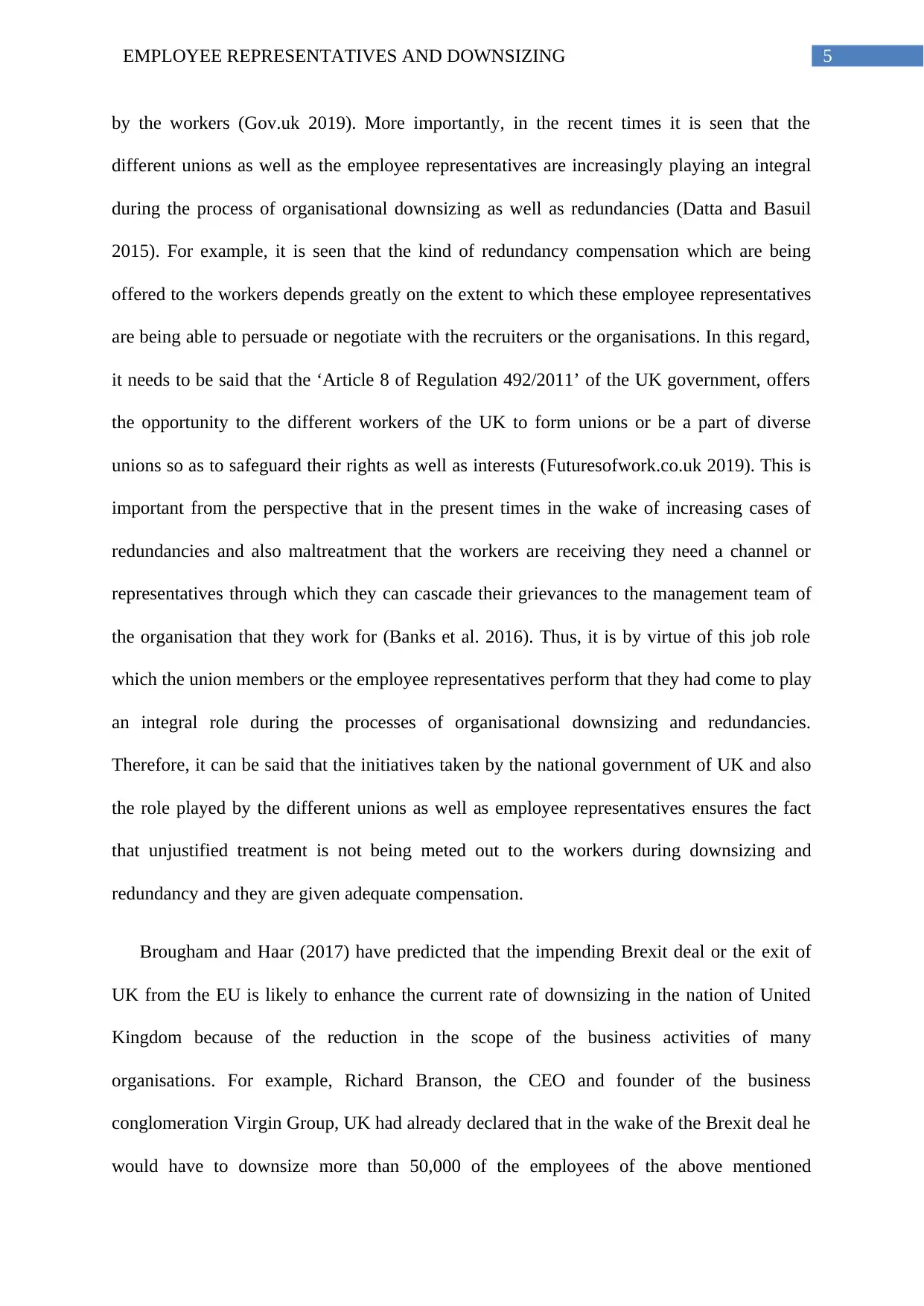
5EMPLOYEE REPRESENTATIVES AND DOWNSIZING
by the workers (Gov.uk 2019). More importantly, in the recent times it is seen that the
different unions as well as the employee representatives are increasingly playing an integral
during the process of organisational downsizing as well as redundancies (Datta and Basuil
2015). For example, it is seen that the kind of redundancy compensation which are being
offered to the workers depends greatly on the extent to which these employee representatives
are being able to persuade or negotiate with the recruiters or the organisations. In this regard,
it needs to be said that the ‘Article 8 of Regulation 492/2011’ of the UK government, offers
the opportunity to the different workers of the UK to form unions or be a part of diverse
unions so as to safeguard their rights as well as interests (Futuresofwork.co.uk 2019). This is
important from the perspective that in the present times in the wake of increasing cases of
redundancies and also maltreatment that the workers are receiving they need a channel or
representatives through which they can cascade their grievances to the management team of
the organisation that they work for (Banks et al. 2016). Thus, it is by virtue of this job role
which the union members or the employee representatives perform that they had come to play
an integral role during the processes of organisational downsizing and redundancies.
Therefore, it can be said that the initiatives taken by the national government of UK and also
the role played by the different unions as well as employee representatives ensures the fact
that unjustified treatment is not being meted out to the workers during downsizing and
redundancy and they are given adequate compensation.
Brougham and Haar (2017) have predicted that the impending Brexit deal or the exit of
UK from the EU is likely to enhance the current rate of downsizing in the nation of United
Kingdom because of the reduction in the scope of the business activities of many
organisations. For example, Richard Branson, the CEO and founder of the business
conglomeration Virgin Group, UK had already declared that in the wake of the Brexit deal he
would have to downsize more than 50,000 of the employees of the above mentioned
by the workers (Gov.uk 2019). More importantly, in the recent times it is seen that the
different unions as well as the employee representatives are increasingly playing an integral
during the process of organisational downsizing as well as redundancies (Datta and Basuil
2015). For example, it is seen that the kind of redundancy compensation which are being
offered to the workers depends greatly on the extent to which these employee representatives
are being able to persuade or negotiate with the recruiters or the organisations. In this regard,
it needs to be said that the ‘Article 8 of Regulation 492/2011’ of the UK government, offers
the opportunity to the different workers of the UK to form unions or be a part of diverse
unions so as to safeguard their rights as well as interests (Futuresofwork.co.uk 2019). This is
important from the perspective that in the present times in the wake of increasing cases of
redundancies and also maltreatment that the workers are receiving they need a channel or
representatives through which they can cascade their grievances to the management team of
the organisation that they work for (Banks et al. 2016). Thus, it is by virtue of this job role
which the union members or the employee representatives perform that they had come to play
an integral role during the processes of organisational downsizing and redundancies.
Therefore, it can be said that the initiatives taken by the national government of UK and also
the role played by the different unions as well as employee representatives ensures the fact
that unjustified treatment is not being meted out to the workers during downsizing and
redundancy and they are given adequate compensation.
Brougham and Haar (2017) have predicted that the impending Brexit deal or the exit of
UK from the EU is likely to enhance the current rate of downsizing in the nation of United
Kingdom because of the reduction in the scope of the business activities of many
organisations. For example, Richard Branson, the CEO and founder of the business
conglomeration Virgin Group, UK had already declared that in the wake of the Brexit deal he
would have to downsize more than 50,000 of the employees of the above mentioned
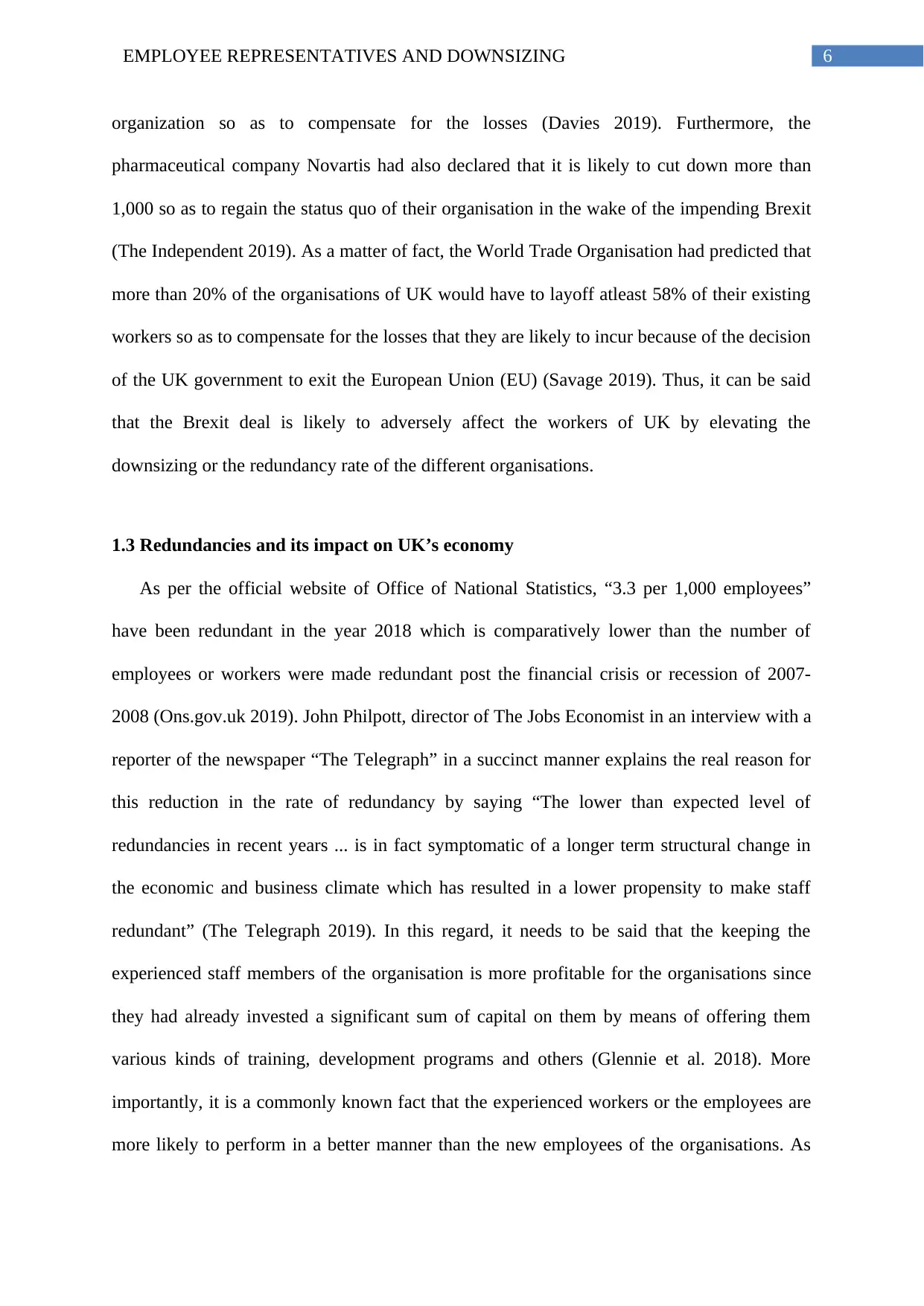
6EMPLOYEE REPRESENTATIVES AND DOWNSIZING
organization so as to compensate for the losses (Davies 2019). Furthermore, the
pharmaceutical company Novartis had also declared that it is likely to cut down more than
1,000 so as to regain the status quo of their organisation in the wake of the impending Brexit
(The Independent 2019). As a matter of fact, the World Trade Organisation had predicted that
more than 20% of the organisations of UK would have to layoff atleast 58% of their existing
workers so as to compensate for the losses that they are likely to incur because of the decision
of the UK government to exit the European Union (EU) (Savage 2019). Thus, it can be said
that the Brexit deal is likely to adversely affect the workers of UK by elevating the
downsizing or the redundancy rate of the different organisations.
1.3 Redundancies and its impact on UK’s economy
As per the official website of Office of National Statistics, “3.3 per 1,000 employees”
have been redundant in the year 2018 which is comparatively lower than the number of
employees or workers were made redundant post the financial crisis or recession of 2007-
2008 (Ons.gov.uk 2019). John Philpott, director of The Jobs Economist in an interview with a
reporter of the newspaper “The Telegraph” in a succinct manner explains the real reason for
this reduction in the rate of redundancy by saying “The lower than expected level of
redundancies in recent years ... is in fact symptomatic of a longer term structural change in
the economic and business climate which has resulted in a lower propensity to make staff
redundant” (The Telegraph 2019). In this regard, it needs to be said that the keeping the
experienced staff members of the organisation is more profitable for the organisations since
they had already invested a significant sum of capital on them by means of offering them
various kinds of training, development programs and others (Glennie et al. 2018). More
importantly, it is a commonly known fact that the experienced workers or the employees are
more likely to perform in a better manner than the new employees of the organisations. As
organization so as to compensate for the losses (Davies 2019). Furthermore, the
pharmaceutical company Novartis had also declared that it is likely to cut down more than
1,000 so as to regain the status quo of their organisation in the wake of the impending Brexit
(The Independent 2019). As a matter of fact, the World Trade Organisation had predicted that
more than 20% of the organisations of UK would have to layoff atleast 58% of their existing
workers so as to compensate for the losses that they are likely to incur because of the decision
of the UK government to exit the European Union (EU) (Savage 2019). Thus, it can be said
that the Brexit deal is likely to adversely affect the workers of UK by elevating the
downsizing or the redundancy rate of the different organisations.
1.3 Redundancies and its impact on UK’s economy
As per the official website of Office of National Statistics, “3.3 per 1,000 employees”
have been redundant in the year 2018 which is comparatively lower than the number of
employees or workers were made redundant post the financial crisis or recession of 2007-
2008 (Ons.gov.uk 2019). John Philpott, director of The Jobs Economist in an interview with a
reporter of the newspaper “The Telegraph” in a succinct manner explains the real reason for
this reduction in the rate of redundancy by saying “The lower than expected level of
redundancies in recent years ... is in fact symptomatic of a longer term structural change in
the economic and business climate which has resulted in a lower propensity to make staff
redundant” (The Telegraph 2019). In this regard, it needs to be said that the keeping the
experienced staff members of the organisation is more profitable for the organisations since
they had already invested a significant sum of capital on them by means of offering them
various kinds of training, development programs and others (Glennie et al. 2018). More
importantly, it is a commonly known fact that the experienced workers or the employees are
more likely to perform in a better manner than the new employees of the organisations. As
Paraphrase This Document
Need a fresh take? Get an instant paraphrase of this document with our AI Paraphraser
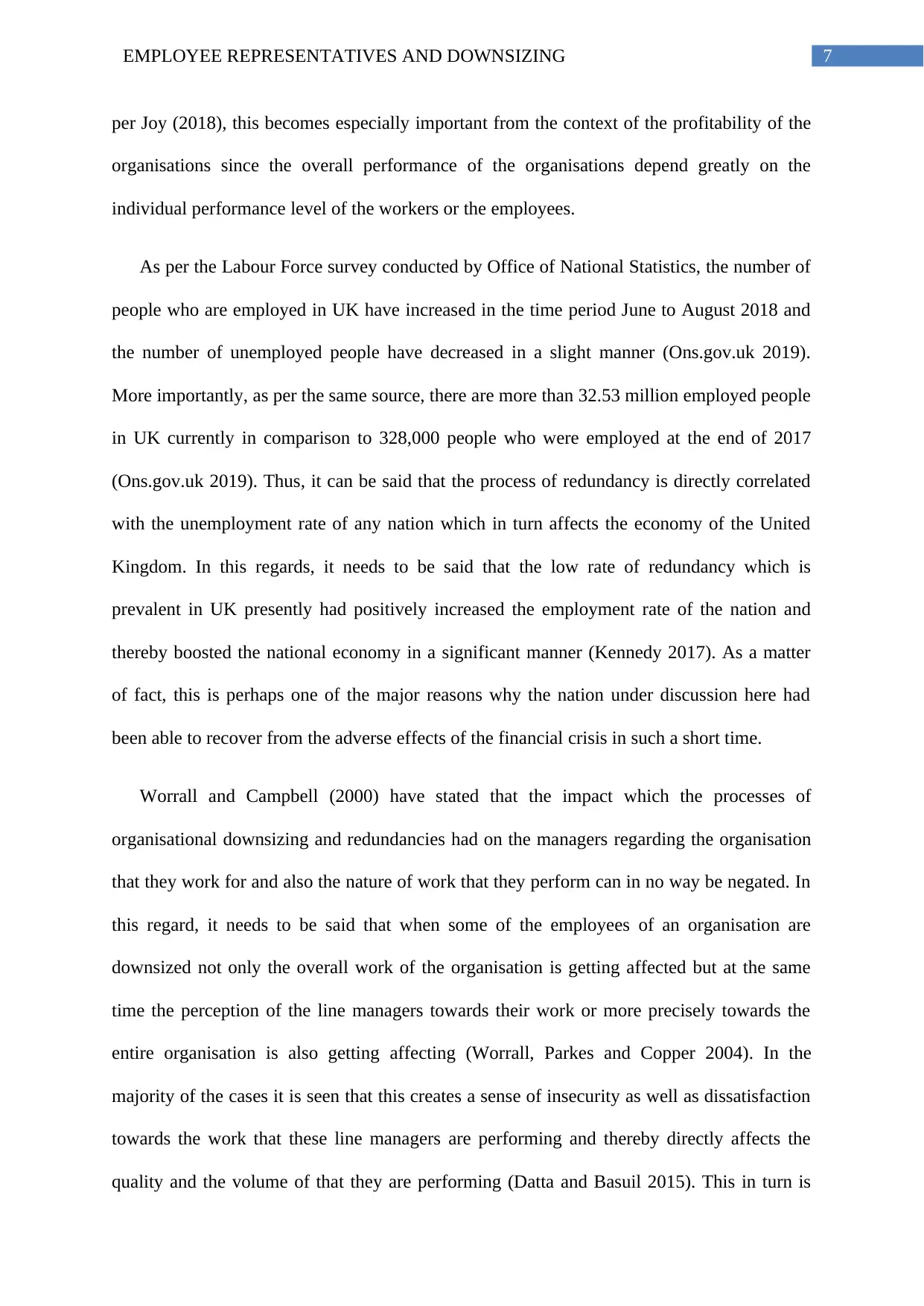
7EMPLOYEE REPRESENTATIVES AND DOWNSIZING
per Joy (2018), this becomes especially important from the context of the profitability of the
organisations since the overall performance of the organisations depend greatly on the
individual performance level of the workers or the employees.
As per the Labour Force survey conducted by Office of National Statistics, the number of
people who are employed in UK have increased in the time period June to August 2018 and
the number of unemployed people have decreased in a slight manner (Ons.gov.uk 2019).
More importantly, as per the same source, there are more than 32.53 million employed people
in UK currently in comparison to 328,000 people who were employed at the end of 2017
(Ons.gov.uk 2019). Thus, it can be said that the process of redundancy is directly correlated
with the unemployment rate of any nation which in turn affects the economy of the United
Kingdom. In this regards, it needs to be said that the low rate of redundancy which is
prevalent in UK presently had positively increased the employment rate of the nation and
thereby boosted the national economy in a significant manner (Kennedy 2017). As a matter
of fact, this is perhaps one of the major reasons why the nation under discussion here had
been able to recover from the adverse effects of the financial crisis in such a short time.
Worrall and Campbell (2000) have stated that the impact which the processes of
organisational downsizing and redundancies had on the managers regarding the organisation
that they work for and also the nature of work that they perform can in no way be negated. In
this regard, it needs to be said that when some of the employees of an organisation are
downsized not only the overall work of the organisation is getting affected but at the same
time the perception of the line managers towards their work or more precisely towards the
entire organisation is also getting affecting (Worrall, Parkes and Copper 2004). In the
majority of the cases it is seen that this creates a sense of insecurity as well as dissatisfaction
towards the work that these line managers are performing and thereby directly affects the
quality and the volume of that they are performing (Datta and Basuil 2015). This in turn is
per Joy (2018), this becomes especially important from the context of the profitability of the
organisations since the overall performance of the organisations depend greatly on the
individual performance level of the workers or the employees.
As per the Labour Force survey conducted by Office of National Statistics, the number of
people who are employed in UK have increased in the time period June to August 2018 and
the number of unemployed people have decreased in a slight manner (Ons.gov.uk 2019).
More importantly, as per the same source, there are more than 32.53 million employed people
in UK currently in comparison to 328,000 people who were employed at the end of 2017
(Ons.gov.uk 2019). Thus, it can be said that the process of redundancy is directly correlated
with the unemployment rate of any nation which in turn affects the economy of the United
Kingdom. In this regards, it needs to be said that the low rate of redundancy which is
prevalent in UK presently had positively increased the employment rate of the nation and
thereby boosted the national economy in a significant manner (Kennedy 2017). As a matter
of fact, this is perhaps one of the major reasons why the nation under discussion here had
been able to recover from the adverse effects of the financial crisis in such a short time.
Worrall and Campbell (2000) have stated that the impact which the processes of
organisational downsizing and redundancies had on the managers regarding the organisation
that they work for and also the nature of work that they perform can in no way be negated. In
this regard, it needs to be said that when some of the employees of an organisation are
downsized not only the overall work of the organisation is getting affected but at the same
time the perception of the line managers towards their work or more precisely towards the
entire organisation is also getting affecting (Worrall, Parkes and Copper 2004). In the
majority of the cases it is seen that this creates a sense of insecurity as well as dissatisfaction
towards the work that these line managers are performing and thereby directly affects the
quality and the volume of that they are performing (Datta and Basuil 2015). This in turn is
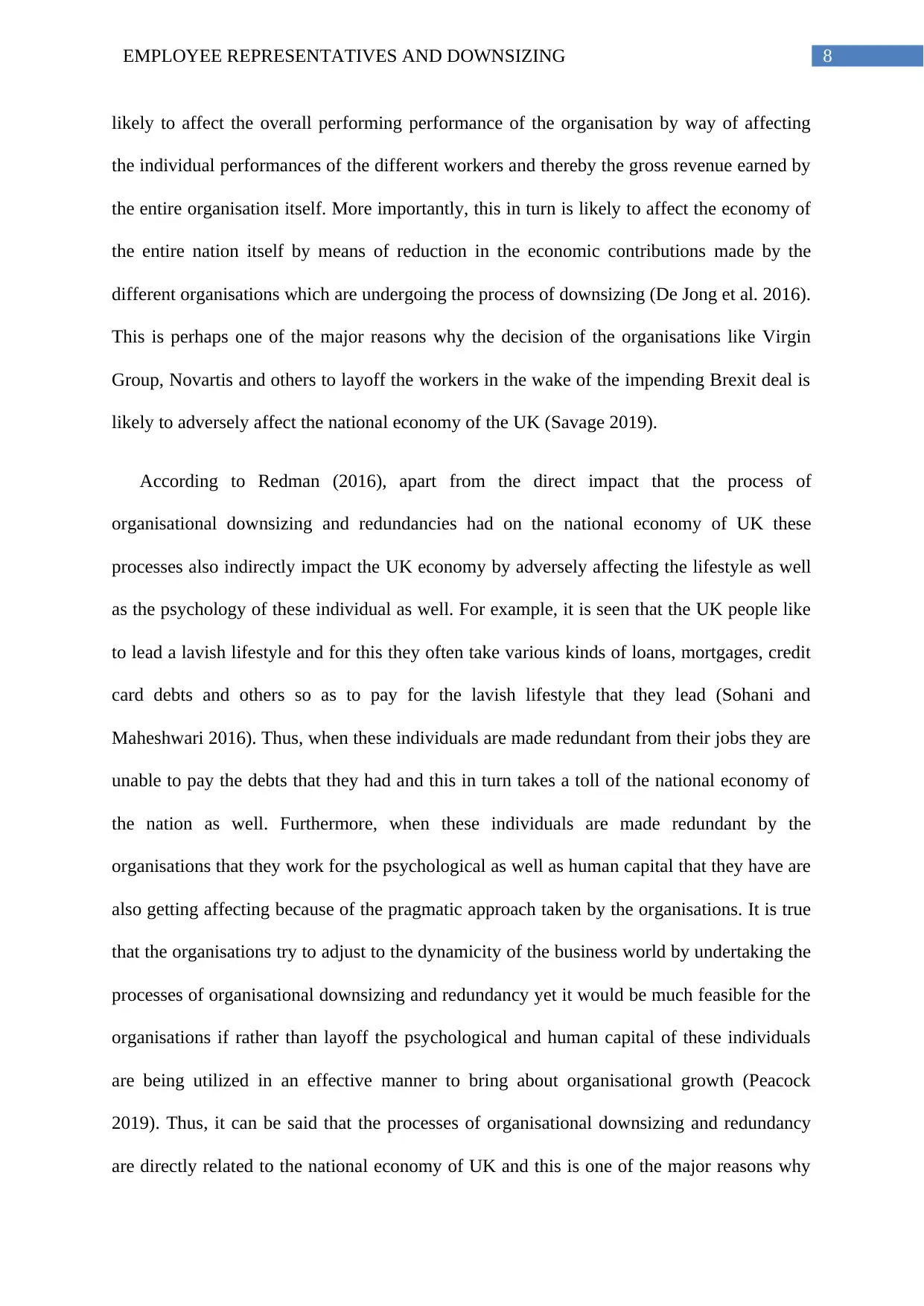
8EMPLOYEE REPRESENTATIVES AND DOWNSIZING
likely to affect the overall performing performance of the organisation by way of affecting
the individual performances of the different workers and thereby the gross revenue earned by
the entire organisation itself. More importantly, this in turn is likely to affect the economy of
the entire nation itself by means of reduction in the economic contributions made by the
different organisations which are undergoing the process of downsizing (De Jong et al. 2016).
This is perhaps one of the major reasons why the decision of the organisations like Virgin
Group, Novartis and others to layoff the workers in the wake of the impending Brexit deal is
likely to adversely affect the national economy of the UK (Savage 2019).
According to Redman (2016), apart from the direct impact that the process of
organisational downsizing and redundancies had on the national economy of UK these
processes also indirectly impact the UK economy by adversely affecting the lifestyle as well
as the psychology of these individual as well. For example, it is seen that the UK people like
to lead a lavish lifestyle and for this they often take various kinds of loans, mortgages, credit
card debts and others so as to pay for the lavish lifestyle that they lead (Sohani and
Maheshwari 2016). Thus, when these individuals are made redundant from their jobs they are
unable to pay the debts that they had and this in turn takes a toll of the national economy of
the nation as well. Furthermore, when these individuals are made redundant by the
organisations that they work for the psychological as well as human capital that they have are
also getting affecting because of the pragmatic approach taken by the organisations. It is true
that the organisations try to adjust to the dynamicity of the business world by undertaking the
processes of organisational downsizing and redundancy yet it would be much feasible for the
organisations if rather than layoff the psychological and human capital of these individuals
are being utilized in an effective manner to bring about organisational growth (Peacock
2019). Thus, it can be said that the processes of organisational downsizing and redundancy
are directly related to the national economy of UK and this is one of the major reasons why
likely to affect the overall performing performance of the organisation by way of affecting
the individual performances of the different workers and thereby the gross revenue earned by
the entire organisation itself. More importantly, this in turn is likely to affect the economy of
the entire nation itself by means of reduction in the economic contributions made by the
different organisations which are undergoing the process of downsizing (De Jong et al. 2016).
This is perhaps one of the major reasons why the decision of the organisations like Virgin
Group, Novartis and others to layoff the workers in the wake of the impending Brexit deal is
likely to adversely affect the national economy of the UK (Savage 2019).
According to Redman (2016), apart from the direct impact that the process of
organisational downsizing and redundancies had on the national economy of UK these
processes also indirectly impact the UK economy by adversely affecting the lifestyle as well
as the psychology of these individual as well. For example, it is seen that the UK people like
to lead a lavish lifestyle and for this they often take various kinds of loans, mortgages, credit
card debts and others so as to pay for the lavish lifestyle that they lead (Sohani and
Maheshwari 2016). Thus, when these individuals are made redundant from their jobs they are
unable to pay the debts that they had and this in turn takes a toll of the national economy of
the nation as well. Furthermore, when these individuals are made redundant by the
organisations that they work for the psychological as well as human capital that they have are
also getting affecting because of the pragmatic approach taken by the organisations. It is true
that the organisations try to adjust to the dynamicity of the business world by undertaking the
processes of organisational downsizing and redundancy yet it would be much feasible for the
organisations if rather than layoff the psychological and human capital of these individuals
are being utilized in an effective manner to bring about organisational growth (Peacock
2019). Thus, it can be said that the processes of organisational downsizing and redundancy
are directly related to the national economy of UK and this is one of the major reasons why
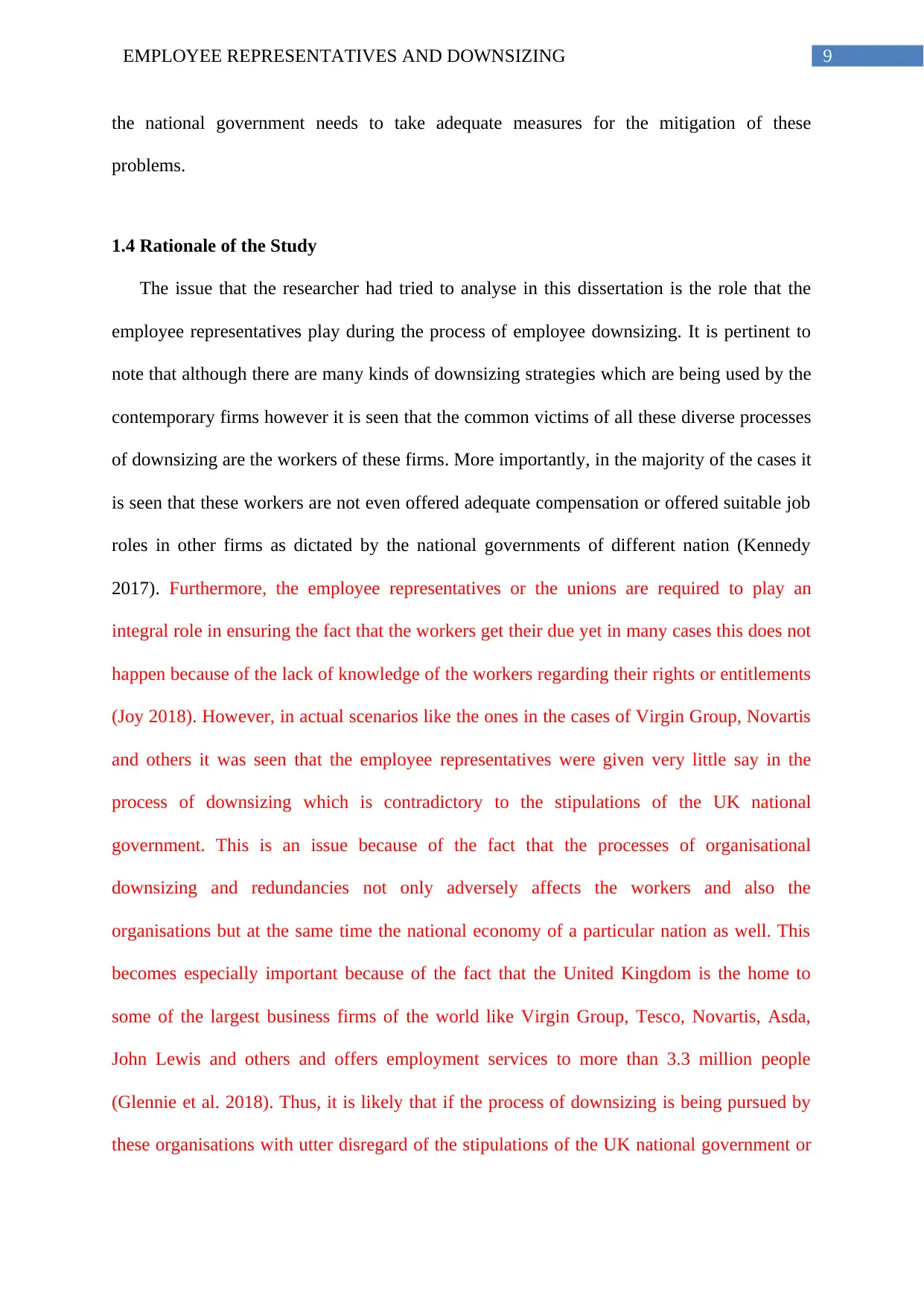
9EMPLOYEE REPRESENTATIVES AND DOWNSIZING
the national government needs to take adequate measures for the mitigation of these
problems.
1.4 Rationale of the Study
The issue that the researcher had tried to analyse in this dissertation is the role that the
employee representatives play during the process of employee downsizing. It is pertinent to
note that although there are many kinds of downsizing strategies which are being used by the
contemporary firms however it is seen that the common victims of all these diverse processes
of downsizing are the workers of these firms. More importantly, in the majority of the cases it
is seen that these workers are not even offered adequate compensation or offered suitable job
roles in other firms as dictated by the national governments of different nation (Kennedy
2017). Furthermore, the employee representatives or the unions are required to play an
integral role in ensuring the fact that the workers get their due yet in many cases this does not
happen because of the lack of knowledge of the workers regarding their rights or entitlements
(Joy 2018). However, in actual scenarios like the ones in the cases of Virgin Group, Novartis
and others it was seen that the employee representatives were given very little say in the
process of downsizing which is contradictory to the stipulations of the UK national
government. This is an issue because of the fact that the processes of organisational
downsizing and redundancies not only adversely affects the workers and also the
organisations but at the same time the national economy of a particular nation as well. This
becomes especially important because of the fact that the United Kingdom is the home to
some of the largest business firms of the world like Virgin Group, Tesco, Novartis, Asda,
John Lewis and others and offers employment services to more than 3.3 million people
(Glennie et al. 2018). Thus, it is likely that if the process of downsizing is being pursued by
these organisations with utter disregard of the stipulations of the UK national government or
the national government needs to take adequate measures for the mitigation of these
problems.
1.4 Rationale of the Study
The issue that the researcher had tried to analyse in this dissertation is the role that the
employee representatives play during the process of employee downsizing. It is pertinent to
note that although there are many kinds of downsizing strategies which are being used by the
contemporary firms however it is seen that the common victims of all these diverse processes
of downsizing are the workers of these firms. More importantly, in the majority of the cases it
is seen that these workers are not even offered adequate compensation or offered suitable job
roles in other firms as dictated by the national governments of different nation (Kennedy
2017). Furthermore, the employee representatives or the unions are required to play an
integral role in ensuring the fact that the workers get their due yet in many cases this does not
happen because of the lack of knowledge of the workers regarding their rights or entitlements
(Joy 2018). However, in actual scenarios like the ones in the cases of Virgin Group, Novartis
and others it was seen that the employee representatives were given very little say in the
process of downsizing which is contradictory to the stipulations of the UK national
government. This is an issue because of the fact that the processes of organisational
downsizing and redundancies not only adversely affects the workers and also the
organisations but at the same time the national economy of a particular nation as well. This
becomes especially important because of the fact that the United Kingdom is the home to
some of the largest business firms of the world like Virgin Group, Tesco, Novartis, Asda,
John Lewis and others and offers employment services to more than 3.3 million people
(Glennie et al. 2018). Thus, it is likely that if the process of downsizing is being pursued by
these organisations with utter disregard of the stipulations of the UK national government or
Secure Best Marks with AI Grader
Need help grading? Try our AI Grader for instant feedback on your assignments.
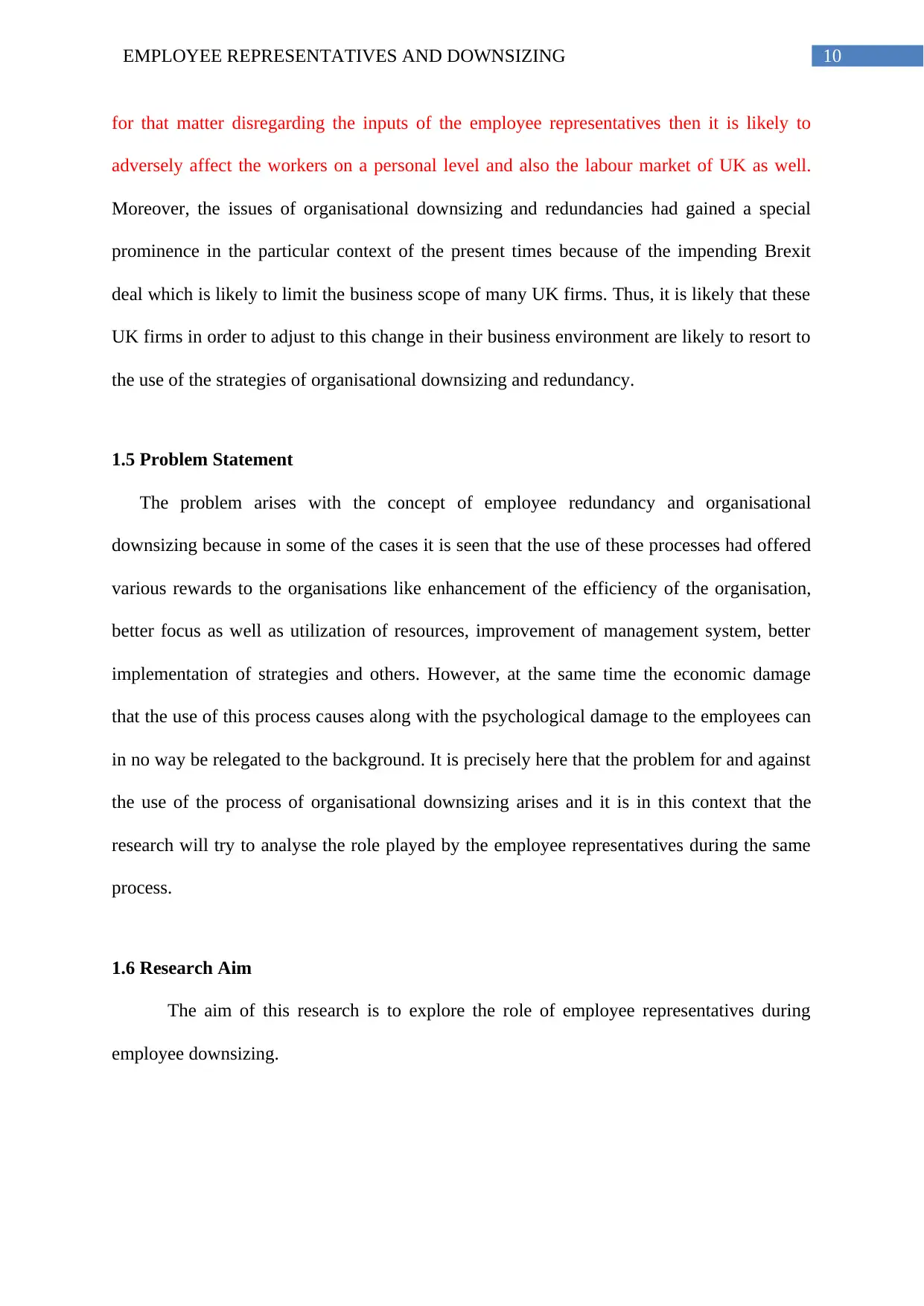
10EMPLOYEE REPRESENTATIVES AND DOWNSIZING
for that matter disregarding the inputs of the employee representatives then it is likely to
adversely affect the workers on a personal level and also the labour market of UK as well.
Moreover, the issues of organisational downsizing and redundancies had gained a special
prominence in the particular context of the present times because of the impending Brexit
deal which is likely to limit the business scope of many UK firms. Thus, it is likely that these
UK firms in order to adjust to this change in their business environment are likely to resort to
the use of the strategies of organisational downsizing and redundancy.
1.5 Problem Statement
The problem arises with the concept of employee redundancy and organisational
downsizing because in some of the cases it is seen that the use of these processes had offered
various rewards to the organisations like enhancement of the efficiency of the organisation,
better focus as well as utilization of resources, improvement of management system, better
implementation of strategies and others. However, at the same time the economic damage
that the use of this process causes along with the psychological damage to the employees can
in no way be relegated to the background. It is precisely here that the problem for and against
the use of the process of organisational downsizing arises and it is in this context that the
research will try to analyse the role played by the employee representatives during the same
process.
1.6 Research Aim
The aim of this research is to explore the role of employee representatives during
employee downsizing.
for that matter disregarding the inputs of the employee representatives then it is likely to
adversely affect the workers on a personal level and also the labour market of UK as well.
Moreover, the issues of organisational downsizing and redundancies had gained a special
prominence in the particular context of the present times because of the impending Brexit
deal which is likely to limit the business scope of many UK firms. Thus, it is likely that these
UK firms in order to adjust to this change in their business environment are likely to resort to
the use of the strategies of organisational downsizing and redundancy.
1.5 Problem Statement
The problem arises with the concept of employee redundancy and organisational
downsizing because in some of the cases it is seen that the use of these processes had offered
various rewards to the organisations like enhancement of the efficiency of the organisation,
better focus as well as utilization of resources, improvement of management system, better
implementation of strategies and others. However, at the same time the economic damage
that the use of this process causes along with the psychological damage to the employees can
in no way be relegated to the background. It is precisely here that the problem for and against
the use of the process of organisational downsizing arises and it is in this context that the
research will try to analyse the role played by the employee representatives during the same
process.
1.6 Research Aim
The aim of this research is to explore the role of employee representatives during
employee downsizing.
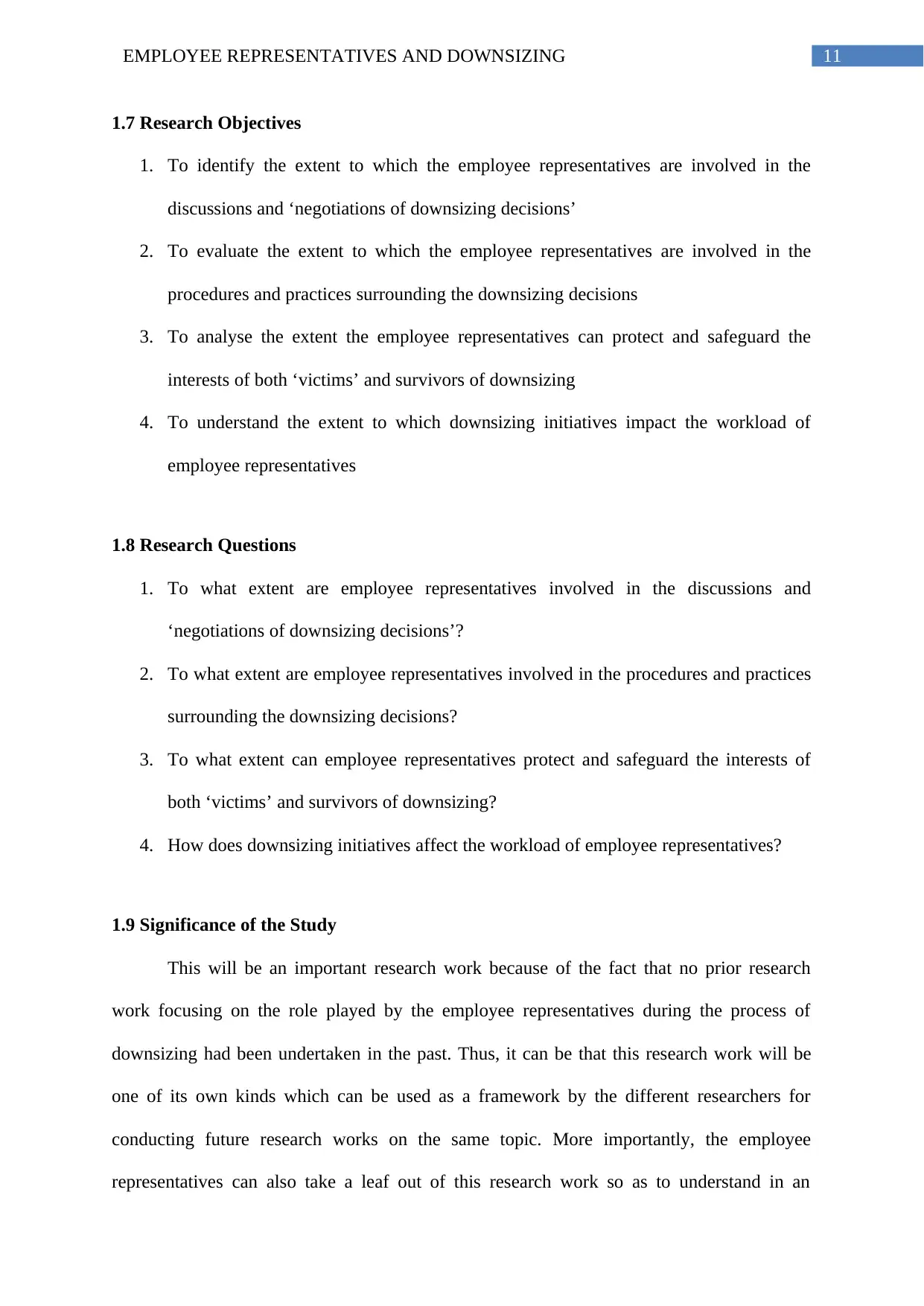
11EMPLOYEE REPRESENTATIVES AND DOWNSIZING
1.7 Research Objectives
1. To identify the extent to which the employee representatives are involved in the
discussions and ‘negotiations of downsizing decisions’
2. To evaluate the extent to which the employee representatives are involved in the
procedures and practices surrounding the downsizing decisions
3. To analyse the extent the employee representatives can protect and safeguard the
interests of both ‘victims’ and survivors of downsizing
4. To understand the extent to which downsizing initiatives impact the workload of
employee representatives
1.8 Research Questions
1. To what extent are employee representatives involved in the discussions and
‘negotiations of downsizing decisions’?
2. To what extent are employee representatives involved in the procedures and practices
surrounding the downsizing decisions?
3. To what extent can employee representatives protect and safeguard the interests of
both ‘victims’ and survivors of downsizing?
4. How does downsizing initiatives affect the workload of employee representatives?
1.9 Significance of the Study
This will be an important research work because of the fact that no prior research
work focusing on the role played by the employee representatives during the process of
downsizing had been undertaken in the past. Thus, it can be that this research work will be
one of its own kinds which can be used as a framework by the different researchers for
conducting future research works on the same topic. More importantly, the employee
representatives can also take a leaf out of this research work so as to understand in an
1.7 Research Objectives
1. To identify the extent to which the employee representatives are involved in the
discussions and ‘negotiations of downsizing decisions’
2. To evaluate the extent to which the employee representatives are involved in the
procedures and practices surrounding the downsizing decisions
3. To analyse the extent the employee representatives can protect and safeguard the
interests of both ‘victims’ and survivors of downsizing
4. To understand the extent to which downsizing initiatives impact the workload of
employee representatives
1.8 Research Questions
1. To what extent are employee representatives involved in the discussions and
‘negotiations of downsizing decisions’?
2. To what extent are employee representatives involved in the procedures and practices
surrounding the downsizing decisions?
3. To what extent can employee representatives protect and safeguard the interests of
both ‘victims’ and survivors of downsizing?
4. How does downsizing initiatives affect the workload of employee representatives?
1.9 Significance of the Study
This will be an important research work because of the fact that no prior research
work focusing on the role played by the employee representatives during the process of
downsizing had been undertaken in the past. Thus, it can be that this research work will be
one of its own kinds which can be used as a framework by the different researchers for
conducting future research works on the same topic. More importantly, the employee
representatives can also take a leaf out of this research work so as to understand in an
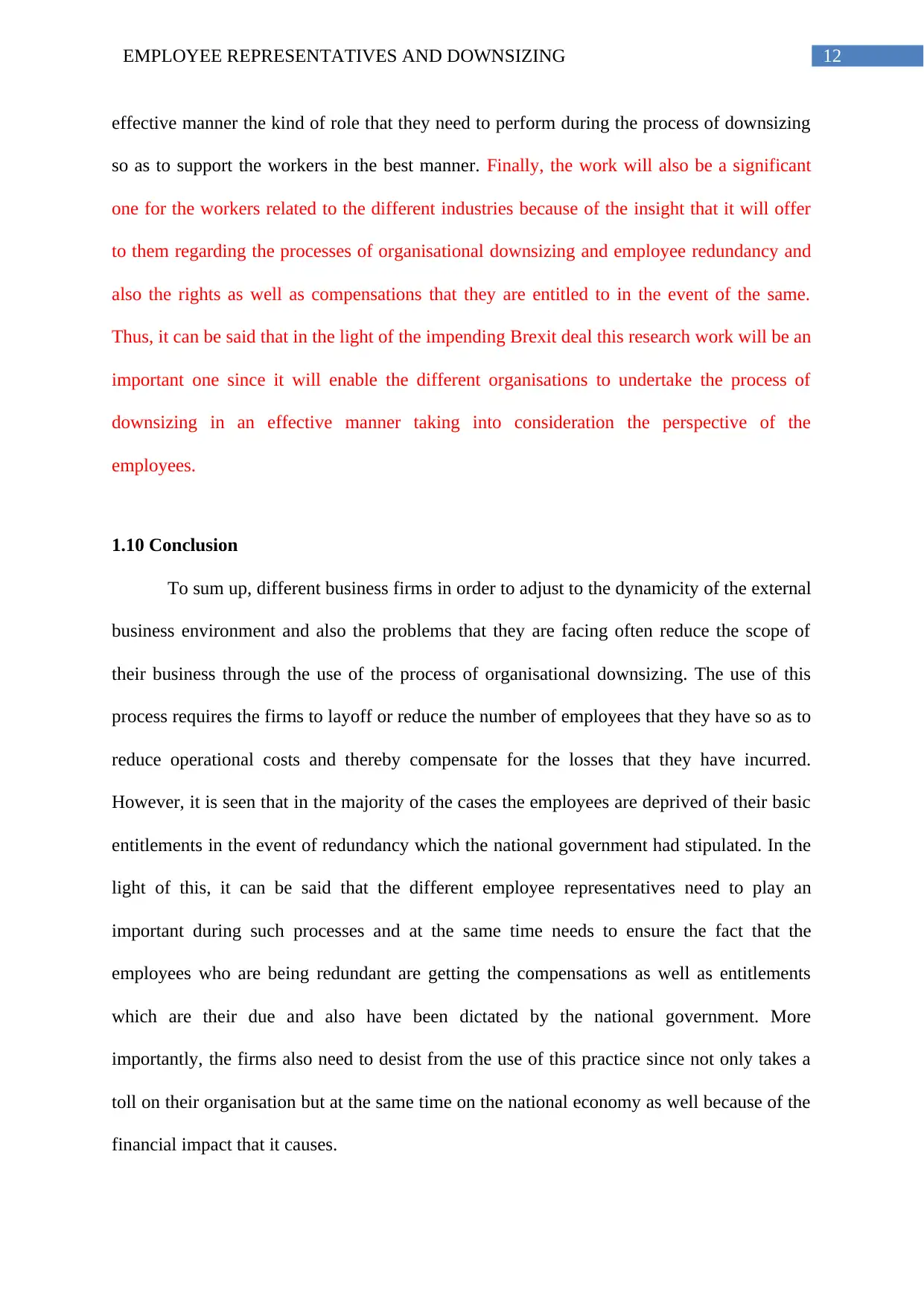
12EMPLOYEE REPRESENTATIVES AND DOWNSIZING
effective manner the kind of role that they need to perform during the process of downsizing
so as to support the workers in the best manner. Finally, the work will also be a significant
one for the workers related to the different industries because of the insight that it will offer
to them regarding the processes of organisational downsizing and employee redundancy and
also the rights as well as compensations that they are entitled to in the event of the same.
Thus, it can be said that in the light of the impending Brexit deal this research work will be an
important one since it will enable the different organisations to undertake the process of
downsizing in an effective manner taking into consideration the perspective of the
employees.
1.10 Conclusion
To sum up, different business firms in order to adjust to the dynamicity of the external
business environment and also the problems that they are facing often reduce the scope of
their business through the use of the process of organisational downsizing. The use of this
process requires the firms to layoff or reduce the number of employees that they have so as to
reduce operational costs and thereby compensate for the losses that they have incurred.
However, it is seen that in the majority of the cases the employees are deprived of their basic
entitlements in the event of redundancy which the national government had stipulated. In the
light of this, it can be said that the different employee representatives need to play an
important during such processes and at the same time needs to ensure the fact that the
employees who are being redundant are getting the compensations as well as entitlements
which are their due and also have been dictated by the national government. More
importantly, the firms also need to desist from the use of this practice since not only takes a
toll on their organisation but at the same time on the national economy as well because of the
financial impact that it causes.
effective manner the kind of role that they need to perform during the process of downsizing
so as to support the workers in the best manner. Finally, the work will also be a significant
one for the workers related to the different industries because of the insight that it will offer
to them regarding the processes of organisational downsizing and employee redundancy and
also the rights as well as compensations that they are entitled to in the event of the same.
Thus, it can be said that in the light of the impending Brexit deal this research work will be an
important one since it will enable the different organisations to undertake the process of
downsizing in an effective manner taking into consideration the perspective of the
employees.
1.10 Conclusion
To sum up, different business firms in order to adjust to the dynamicity of the external
business environment and also the problems that they are facing often reduce the scope of
their business through the use of the process of organisational downsizing. The use of this
process requires the firms to layoff or reduce the number of employees that they have so as to
reduce operational costs and thereby compensate for the losses that they have incurred.
However, it is seen that in the majority of the cases the employees are deprived of their basic
entitlements in the event of redundancy which the national government had stipulated. In the
light of this, it can be said that the different employee representatives need to play an
important during such processes and at the same time needs to ensure the fact that the
employees who are being redundant are getting the compensations as well as entitlements
which are their due and also have been dictated by the national government. More
importantly, the firms also need to desist from the use of this practice since not only takes a
toll on their organisation but at the same time on the national economy as well because of the
financial impact that it causes.
Paraphrase This Document
Need a fresh take? Get an instant paraphrase of this document with our AI Paraphraser

13EMPLOYEE REPRESENTATIVES AND DOWNSIZING
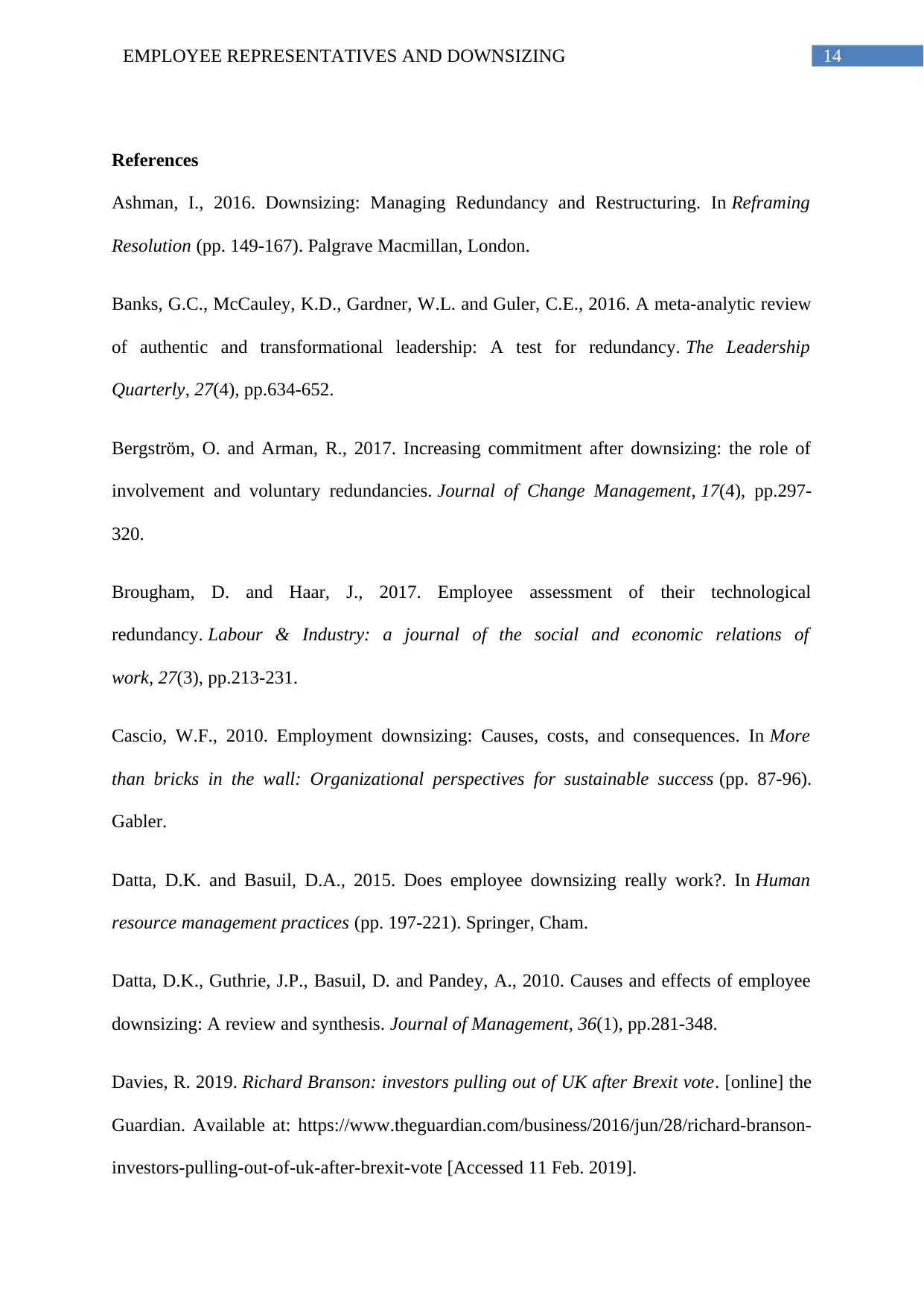
14EMPLOYEE REPRESENTATIVES AND DOWNSIZING
References
Ashman, I., 2016. Downsizing: Managing Redundancy and Restructuring. In Reframing
Resolution (pp. 149-167). Palgrave Macmillan, London.
Banks, G.C., McCauley, K.D., Gardner, W.L. and Guler, C.E., 2016. A meta-analytic review
of authentic and transformational leadership: A test for redundancy. The Leadership
Quarterly, 27(4), pp.634-652.
Bergström, O. and Arman, R., 2017. Increasing commitment after downsizing: the role of
involvement and voluntary redundancies. Journal of Change Management, 17(4), pp.297-
320.
Brougham, D. and Haar, J., 2017. Employee assessment of their technological
redundancy. Labour & Industry: a journal of the social and economic relations of
work, 27(3), pp.213-231.
Cascio, W.F., 2010. Employment downsizing: Causes, costs, and consequences. In More
than bricks in the wall: Organizational perspectives for sustainable success (pp. 87-96).
Gabler.
Datta, D.K. and Basuil, D.A., 2015. Does employee downsizing really work?. In Human
resource management practices (pp. 197-221). Springer, Cham.
Datta, D.K., Guthrie, J.P., Basuil, D. and Pandey, A., 2010. Causes and effects of employee
downsizing: A review and synthesis. Journal of Management, 36(1), pp.281-348.
Davies, R. 2019. Richard Branson: investors pulling out of UK after Brexit vote. [online] the
Guardian. Available at: https://www.theguardian.com/business/2016/jun/28/richard-branson-
investors-pulling-out-of-uk-after-brexit-vote [Accessed 11 Feb. 2019].
References
Ashman, I., 2016. Downsizing: Managing Redundancy and Restructuring. In Reframing
Resolution (pp. 149-167). Palgrave Macmillan, London.
Banks, G.C., McCauley, K.D., Gardner, W.L. and Guler, C.E., 2016. A meta-analytic review
of authentic and transformational leadership: A test for redundancy. The Leadership
Quarterly, 27(4), pp.634-652.
Bergström, O. and Arman, R., 2017. Increasing commitment after downsizing: the role of
involvement and voluntary redundancies. Journal of Change Management, 17(4), pp.297-
320.
Brougham, D. and Haar, J., 2017. Employee assessment of their technological
redundancy. Labour & Industry: a journal of the social and economic relations of
work, 27(3), pp.213-231.
Cascio, W.F., 2010. Employment downsizing: Causes, costs, and consequences. In More
than bricks in the wall: Organizational perspectives for sustainable success (pp. 87-96).
Gabler.
Datta, D.K. and Basuil, D.A., 2015. Does employee downsizing really work?. In Human
resource management practices (pp. 197-221). Springer, Cham.
Datta, D.K., Guthrie, J.P., Basuil, D. and Pandey, A., 2010. Causes and effects of employee
downsizing: A review and synthesis. Journal of Management, 36(1), pp.281-348.
Davies, R. 2019. Richard Branson: investors pulling out of UK after Brexit vote. [online] the
Guardian. Available at: https://www.theguardian.com/business/2016/jun/28/richard-branson-
investors-pulling-out-of-uk-after-brexit-vote [Accessed 11 Feb. 2019].
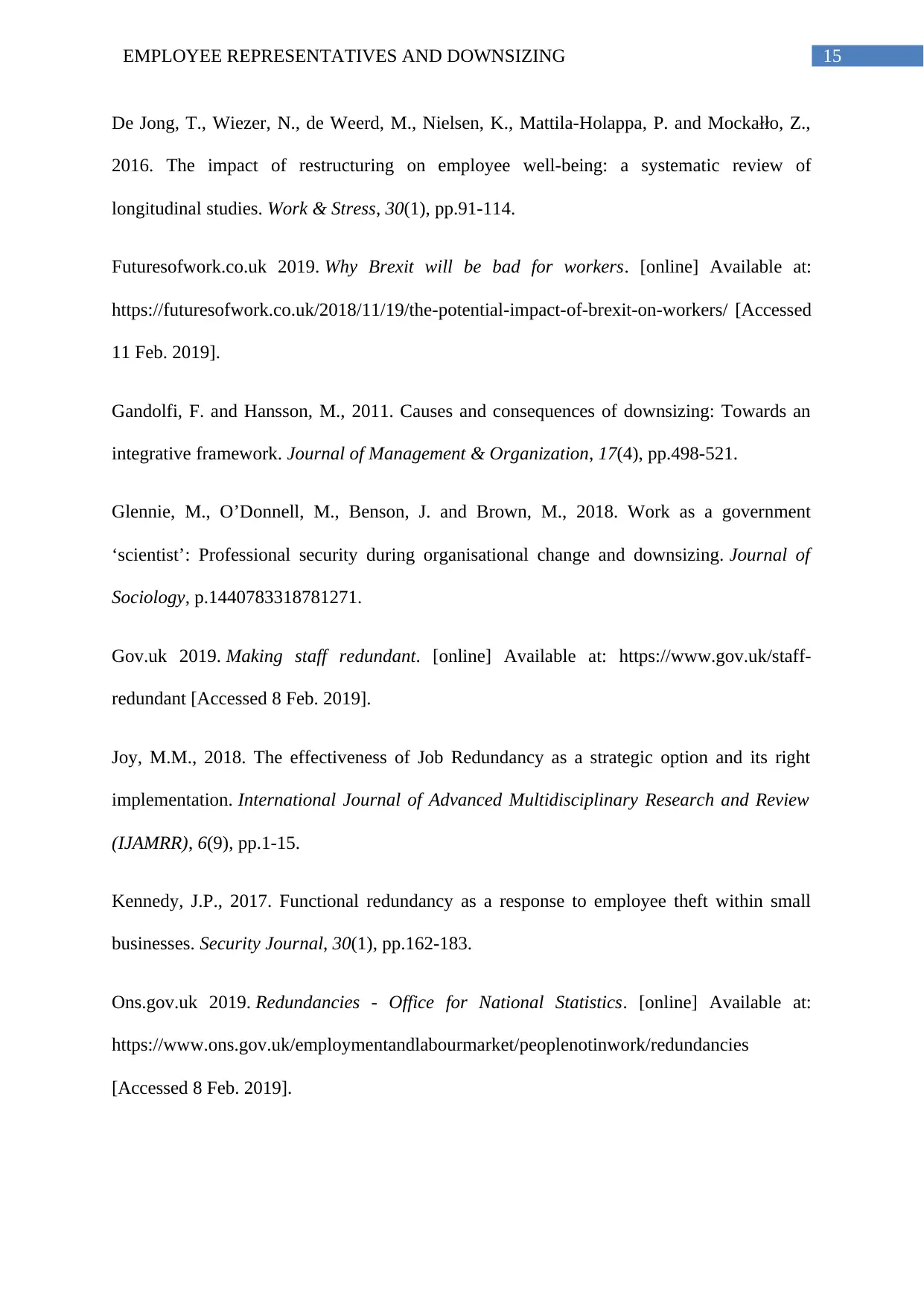
15EMPLOYEE REPRESENTATIVES AND DOWNSIZING
De Jong, T., Wiezer, N., de Weerd, M., Nielsen, K., Mattila-Holappa, P. and Mockałło, Z.,
2016. The impact of restructuring on employee well-being: a systematic review of
longitudinal studies. Work & Stress, 30(1), pp.91-114.
Futuresofwork.co.uk 2019. Why Brexit will be bad for workers. [online] Available at:
https://futuresofwork.co.uk/2018/11/19/the-potential-impact-of-brexit-on-workers/ [Accessed
11 Feb. 2019].
Gandolfi, F. and Hansson, M., 2011. Causes and consequences of downsizing: Towards an
integrative framework. Journal of Management & Organization, 17(4), pp.498-521.
Glennie, M., O’Donnell, M., Benson, J. and Brown, M., 2018. Work as a government
‘scientist’: Professional security during organisational change and downsizing. Journal of
Sociology, p.1440783318781271.
Gov.uk 2019. Making staff redundant. [online] Available at: https://www.gov.uk/staff-
redundant [Accessed 8 Feb. 2019].
Joy, M.M., 2018. The effectiveness of Job Redundancy as a strategic option and its right
implementation. International Journal of Advanced Multidisciplinary Research and Review
(IJAMRR), 6(9), pp.1-15.
Kennedy, J.P., 2017. Functional redundancy as a response to employee theft within small
businesses. Security Journal, 30(1), pp.162-183.
Ons.gov.uk 2019. Redundancies - Office for National Statistics. [online] Available at:
https://www.ons.gov.uk/employmentandlabourmarket/peoplenotinwork/redundancies
[Accessed 8 Feb. 2019].
De Jong, T., Wiezer, N., de Weerd, M., Nielsen, K., Mattila-Holappa, P. and Mockałło, Z.,
2016. The impact of restructuring on employee well-being: a systematic review of
longitudinal studies. Work & Stress, 30(1), pp.91-114.
Futuresofwork.co.uk 2019. Why Brexit will be bad for workers. [online] Available at:
https://futuresofwork.co.uk/2018/11/19/the-potential-impact-of-brexit-on-workers/ [Accessed
11 Feb. 2019].
Gandolfi, F. and Hansson, M., 2011. Causes and consequences of downsizing: Towards an
integrative framework. Journal of Management & Organization, 17(4), pp.498-521.
Glennie, M., O’Donnell, M., Benson, J. and Brown, M., 2018. Work as a government
‘scientist’: Professional security during organisational change and downsizing. Journal of
Sociology, p.1440783318781271.
Gov.uk 2019. Making staff redundant. [online] Available at: https://www.gov.uk/staff-
redundant [Accessed 8 Feb. 2019].
Joy, M.M., 2018. The effectiveness of Job Redundancy as a strategic option and its right
implementation. International Journal of Advanced Multidisciplinary Research and Review
(IJAMRR), 6(9), pp.1-15.
Kennedy, J.P., 2017. Functional redundancy as a response to employee theft within small
businesses. Security Journal, 30(1), pp.162-183.
Ons.gov.uk 2019. Redundancies - Office for National Statistics. [online] Available at:
https://www.ons.gov.uk/employmentandlabourmarket/peoplenotinwork/redundancies
[Accessed 8 Feb. 2019].
Secure Best Marks with AI Grader
Need help grading? Try our AI Grader for instant feedback on your assignments.
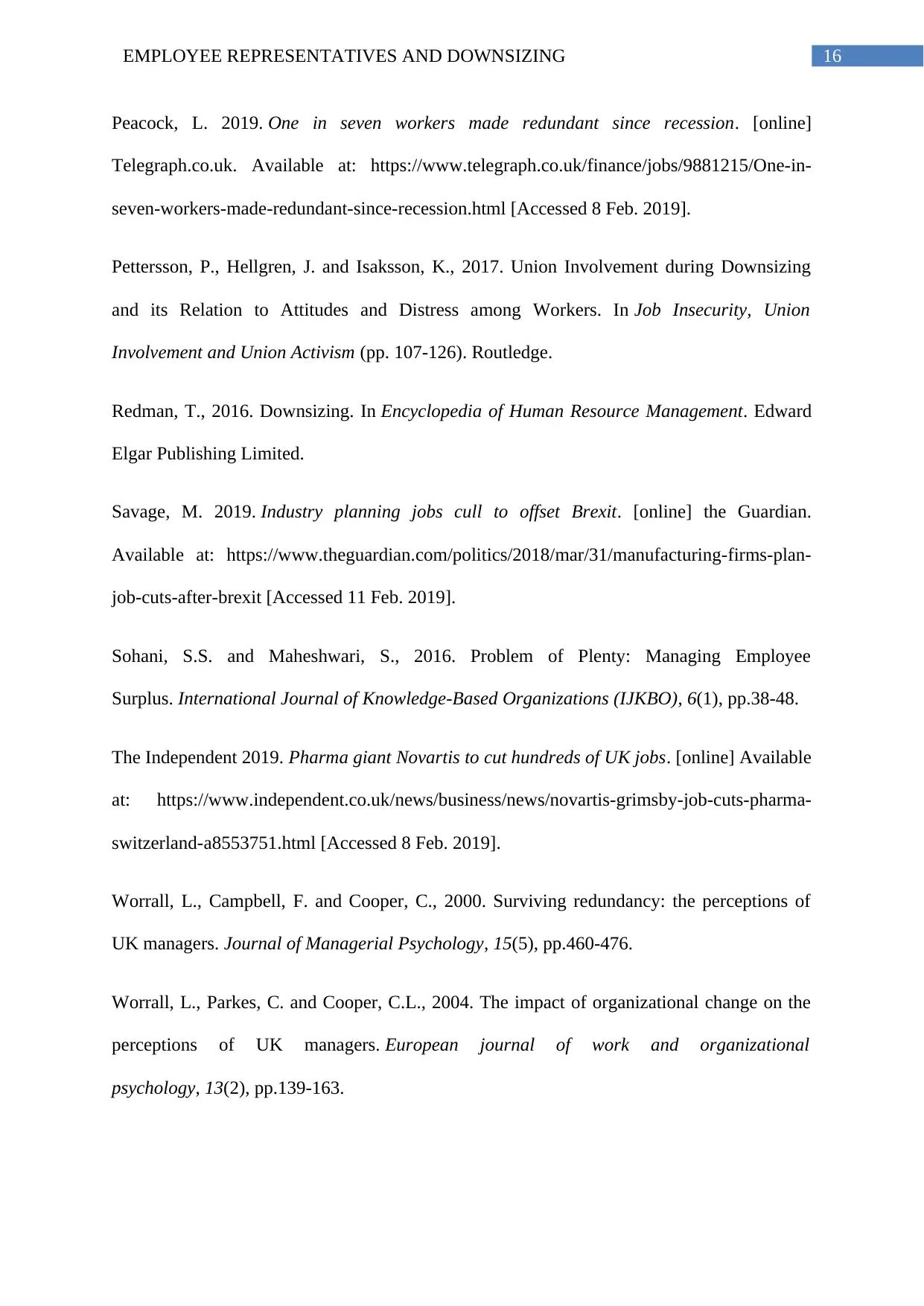
16EMPLOYEE REPRESENTATIVES AND DOWNSIZING
Peacock, L. 2019. One in seven workers made redundant since recession. [online]
Telegraph.co.uk. Available at: https://www.telegraph.co.uk/finance/jobs/9881215/One-in-
seven-workers-made-redundant-since-recession.html [Accessed 8 Feb. 2019].
Pettersson, P., Hellgren, J. and Isaksson, K., 2017. Union Involvement during Downsizing
and its Relation to Attitudes and Distress among Workers. In Job Insecurity, Union
Involvement and Union Activism (pp. 107-126). Routledge.
Redman, T., 2016. Downsizing. In Encyclopedia of Human Resource Management. Edward
Elgar Publishing Limited.
Savage, M. 2019. Industry planning jobs cull to offset Brexit. [online] the Guardian.
Available at: https://www.theguardian.com/politics/2018/mar/31/manufacturing-firms-plan-
job-cuts-after-brexit [Accessed 11 Feb. 2019].
Sohani, S.S. and Maheshwari, S., 2016. Problem of Plenty: Managing Employee
Surplus. International Journal of Knowledge-Based Organizations (IJKBO), 6(1), pp.38-48.
The Independent 2019. Pharma giant Novartis to cut hundreds of UK jobs. [online] Available
at: https://www.independent.co.uk/news/business/news/novartis-grimsby-job-cuts-pharma-
switzerland-a8553751.html [Accessed 8 Feb. 2019].
Worrall, L., Campbell, F. and Cooper, C., 2000. Surviving redundancy: the perceptions of
UK managers. Journal of Managerial Psychology, 15(5), pp.460-476.
Worrall, L., Parkes, C. and Cooper, C.L., 2004. The impact of organizational change on the
perceptions of UK managers. European journal of work and organizational
psychology, 13(2), pp.139-163.
Peacock, L. 2019. One in seven workers made redundant since recession. [online]
Telegraph.co.uk. Available at: https://www.telegraph.co.uk/finance/jobs/9881215/One-in-
seven-workers-made-redundant-since-recession.html [Accessed 8 Feb. 2019].
Pettersson, P., Hellgren, J. and Isaksson, K., 2017. Union Involvement during Downsizing
and its Relation to Attitudes and Distress among Workers. In Job Insecurity, Union
Involvement and Union Activism (pp. 107-126). Routledge.
Redman, T., 2016. Downsizing. In Encyclopedia of Human Resource Management. Edward
Elgar Publishing Limited.
Savage, M. 2019. Industry planning jobs cull to offset Brexit. [online] the Guardian.
Available at: https://www.theguardian.com/politics/2018/mar/31/manufacturing-firms-plan-
job-cuts-after-brexit [Accessed 11 Feb. 2019].
Sohani, S.S. and Maheshwari, S., 2016. Problem of Plenty: Managing Employee
Surplus. International Journal of Knowledge-Based Organizations (IJKBO), 6(1), pp.38-48.
The Independent 2019. Pharma giant Novartis to cut hundreds of UK jobs. [online] Available
at: https://www.independent.co.uk/news/business/news/novartis-grimsby-job-cuts-pharma-
switzerland-a8553751.html [Accessed 8 Feb. 2019].
Worrall, L., Campbell, F. and Cooper, C., 2000. Surviving redundancy: the perceptions of
UK managers. Journal of Managerial Psychology, 15(5), pp.460-476.
Worrall, L., Parkes, C. and Cooper, C.L., 2004. The impact of organizational change on the
perceptions of UK managers. European journal of work and organizational
psychology, 13(2), pp.139-163.
1 out of 17
Related Documents
Your All-in-One AI-Powered Toolkit for Academic Success.
+13062052269
info@desklib.com
Available 24*7 on WhatsApp / Email
![[object Object]](/_next/static/media/star-bottom.7253800d.svg)
Unlock your academic potential
© 2024 | Zucol Services PVT LTD | All rights reserved.





